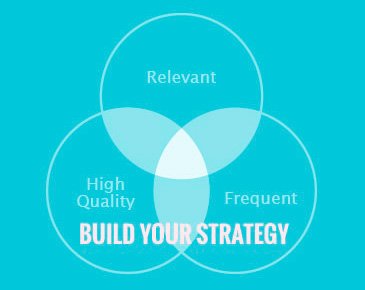Diving into content marketing without a strategy is akin to creating a TV ad that doesn’t have a media buy to support it. Without a media buy, you don’t know the audience, you don’t know the distribution method, and you don’t know how on earth it is ever going to be successful.
At Tippingpoint Labs, we think about 4 frameworks or philosophies or tenets or whatever you want to call them when developing a strategy. These are not novel or unknown. What is unique is our ability to commit to goals and create a strategy and structure for our clients that works.
Content marketing framework #1: Create Relevant, High-Quality, and Frequent Content
I am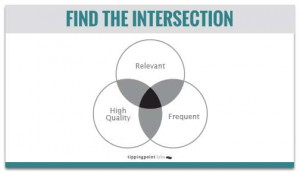 tired of seeing Venn diagrams too. But the intersection between Relevant, High-Quality, and Frequent content is the place where Marketers are going to find content marketing success. Brands can no longer rely on one great high-quality video to make an impact. Brands can longer rely on 5 tweets a day that add no value to build a relationship with an audience. And Brands can no longer think that creating loads of content for various audience profiles will encourage their audience to sift through it all to find what is relevant for them. It is not going to happen. None of these disparate approaches build lasting relationships.
tired of seeing Venn diagrams too. But the intersection between Relevant, High-Quality, and Frequent content is the place where Marketers are going to find content marketing success. Brands can no longer rely on one great high-quality video to make an impact. Brands can longer rely on 5 tweets a day that add no value to build a relationship with an audience. And Brands can no longer think that creating loads of content for various audience profiles will encourage their audience to sift through it all to find what is relevant for them. It is not going to happen. None of these disparate approaches build lasting relationships.
You have be more honest than that with yourself and your team. Figure our what frequency you can truly create content based on the quality you can produce and the insight you can offer for your audience profiles. Find that intersection and commit to those values.
Content marketing framework #2: McKinsey’s Consumer Decision Journey
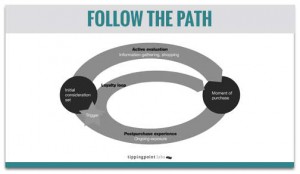 Yes, this has been out for ages, but it still applies. There is a key takeaway from this journey that must be considered. It is the path to purchase. And the path is basically the same for all prospects.
Yes, this has been out for ages, but it still applies. There is a key takeaway from this journey that must be considered. It is the path to purchase. And the path is basically the same for all prospects.
The prospect gets triggered into thinking about about a purchase. For example, your prospect wants a new stand mixer. Why? Hers broke down. She is getting married. Her friend made great cookies using her stand mixer. She saw a HomeGoods ad with one and it made her nostalgic for her mother. There are a million triggers and some you, as the brand, create by producing ads, content, etc and some you simply benefit from. But once that trigger happens, the prospect is now on the path. The path to find information about all stand mixers, to read reviews, to visit websites, to talk to her friends about it. She is active. She is engaged. She is watching videos and buying Consumer Reports.
This stage is where key information about your product needs to be found and it needs to be useful. By useful I mean it needs to propel her to the “Moment of Purchase”. If it does not, it is not useful. The closer she moves along that “Active Evaluation” stage to the “Moment of Purchase” the more your content needs to sing and stand out and be on-target.
Once the prospect becomes the customer, your content needs to shift. You are now fostering the relationship. You are now engaging with her about recipes to make with her new stand mixer. You are now showing her tricks to make her stand mixer more useful. Because the more useful this product, the more likely she is to purchase another one from you. And you want her to think of you when she needs a blender for her epic BBQ sauce.
So, if you are creating content and not knowing what stage your prospect or customer is in, then the content is wildly inefficient and ineffective. The journey requires that you know who you are targeting and where they are in the purchasing cycle. You may need content strategies for multiple audience segments in multiple stages of the journey. That’s ok. (And, if that is the case, we can help you formulate a plan around that too.)
Content marketing framework #3: The Digital Universe
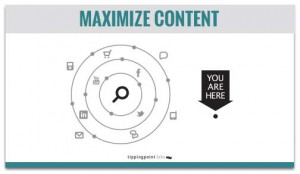
Your brand is not the center of the universe. Search is. No longer can you build it and they will come. You have to know the platforms on which you plan to distribute because, guess what? The audience expectations on each platform are different. Go back to framework #1. Relevant. High Quality. Frequent. If you do not think this varies by platform, then think about the expectations of the audience on LinkedIn versus Twitter. Platforms matter. Determine those first before you start to create content, otherwise it is like creating a TV ad with no media buy. You don’t know the context of where your content will be. And context matters.
Content marketing framework #4: Measure and Refine
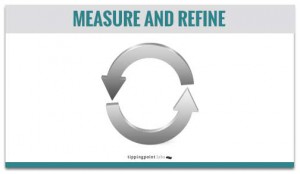
Digital provides immediate (okay almost immediate) results. Brands have to take advantage of that. Jim and I get asked all the time, how do I know what metrics matter? How do I know what to measure? We reply with, what are your objectives? Are you trying to trigger your prospects aka form a relationship aka build awareness aka measure site traffic? Or are you trying to forge relationships with existing customers aka solidify a relationship aka drive engagement aka measure view times rates on video? It all starts with knowing your objective and once you know that, the metrics are easier to identify. And then you can refine and improve your content based on results.
Wrapping it up
Apologies for the long post, but the strategy truly is the most important thing.
- Determine the intersection that best allows you to create relevant, high quality, frequent content.
- Know what stage of the purchasing path you are addressing with the audience.
- Understand where you plan to distribute the content.
- Measure the metrics that matter.
All of this came out of a presentation we recently gave at the In-House Agency Forum’s Annual Conference focused on “Game Changers”.
Our next post is about building an internal content marketing team and assigning roles, aka a newsroom approach. Read it now.
Want a copy of our full presentation? Email us at jcosco – at – tippingpointlabs dot com.
